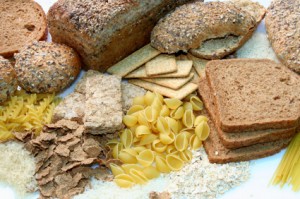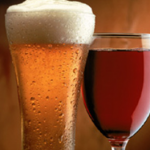Good Carbs vs Bad Carbs
 Carbs, or better known as carbohydrates play a huge role in our nutrition and provide a majority of our energy. With this in mind, we need to understand them and know how to use carbs to benefit our health and fitness goals rather than sabotage them. If you dont know the difference between a good carb and a bad carb, take a seat, because you NEED to know in order to maximize your results!
Carbs, or better known as carbohydrates play a huge role in our nutrition and provide a majority of our energy. With this in mind, we need to understand them and know how to use carbs to benefit our health and fitness goals rather than sabotage them. If you dont know the difference between a good carb and a bad carb, take a seat, because you NEED to know in order to maximize your results!
First off…What are Carbohydrates? Carbohydrates are transported through the body in the form of glucose to be burned as fuel. The length of each glucose molecule chain determines how it will be used as energy in your body. To keep things simple, carbohydrates can be divided into two different types: good carbohydrates and bad carbohydrates.
Good Carbs vs. Bad Carbs
I want you first to understand what bad carbs are so that they can be avoided like the plague!
Bad Carbs
Bad carbs are the shorter glucose chains that the body can easily break down and use for immediate energy. You might often hear these referred to as simple carbs. This means that they will give you one big blob of energy, all at once. This will demolish your hopes of weight loss and leave you with what is called a crash. The bad carb (or simple carb) spikes your blood sugar, which is what is responsible for the sudden burst of energy. This is why we like simple carbs so much. What we don’t consider is coming down from that blood sugar spike. Your blood sugar levels crash after a short period of time and you end up craving more sugar. It’s a nasty rollercoaster ride. This sugar spike will also raise your insulin levels and can really cripple your opportunity to burn much fat. This rise in the level of insulin released by your body will aid your body in storing more fat, while also depleting your energy levels. In short, stay away from simple carbs! You dont need em and you dont want em!
What are some of the bad carbs? Ever hear the saying “the whiter the bread, the quicker your dead”? This is a good rule of thumb. Usually bad carbs are more processed and are lighter in color.
Here is a list of common bad carbs:
- White Bread
- Corn
- Potatoes
- Non Whole Wheat Pastas
- Sugary Cereals
Good Carbs
These are the longer of the glucose molecule chains and are far more reluctant to release their energy so quickly. These avoid the sugar spike and keep your insulin levels lower. As a direct result of this, you will burn more fat for energy and you will feel more energetic! No more crashing!!! Good carbohydrates are very good at keeping the fire stoked that is your metabolism. This is because they release their energy much slower, which provides you with more consistent energy for your muscles to work with, and stable energy levels. We all want more energy so we can BRING IT during our workouts right?
So what are some of the good carbs?
- Whole Wheat Bread
- Whole Wheat Pastas
- Oats
- Fruit (Has simple carbs, but lots of fiber)
- Veggies
- Fat Free Dairy
- Beans
All carbs are evaluated using the Glycemic Index (the whua?) First, what does glycemic index mean? When looking at a food, the glycemic index of a food is a rank that describes its effect on our blood glucose levels. A food’s glycemic index is based on glucose, which is one of the fastest absorbing carbohydrates available. Glucose is given an arbitrary value of 100 and other carbs are given a number relative to glucose. Glycemic Index values are given to carbohydrate containing foods (you won’t find G.I. values for proteins like beef, chicken, or fish). Proteins don’t spike blood sugar so they don’t really have a place on the G.I.
The glycemic index is broken down into 3 categories – High (70+), Medium (56-69), and Low (less than 55). So when selecting foods containing carbs, the better choice is the one with the lower glycemic index! The lower, the better!
Watch this video, which explains the Glycemic Index and how it affects your body, as well as where Shakeology fits into the Glycemic Index:
Take a look at this list and see where some of our “favorites” rank on the GI:
Shakeology = 24 (Low)
Apples = 38 (Low)
Bananas = 54 (Low)
Strawberries = 32 (Low)
Cherries = 22 (Low)
Grapes = 46 (Low)
Pears = 38 (Low)
Peaches = 42 (Low)
Watermelon = 71 (HIGH!!)
Carrots = 20 (Low)
Brocolli =15 (Low)
Black Beans = 30 (Low)
Corn = 78 (HIGH!!)
Sweet Potato = 54 (Low)
Potato = 85 (HIGH!!)
White Bread = 71 (HIGH!!)
Wheat Bread = 50 (Low)
Milk, skim = 32 (Low)
The goal in all this was not to try and confuse you with all this terminology of Glycemic Index and Glucose Levels, but it was to try and give you an understanding of how your body reacts to certain types of carbs. The goal was also to help YOU make the food choices that will maximize your results.
There is tons to learn about the Glycemic Index if you are interested, but the thing we all need to understand is that not all carbs are the same, and keeping our bodies fueled with a sustained source of slow-releasing energy is the best way to stay fit and healthy. Proteins and low GI carbs are the best way to achieve this!
Related Posts















Recent Comments